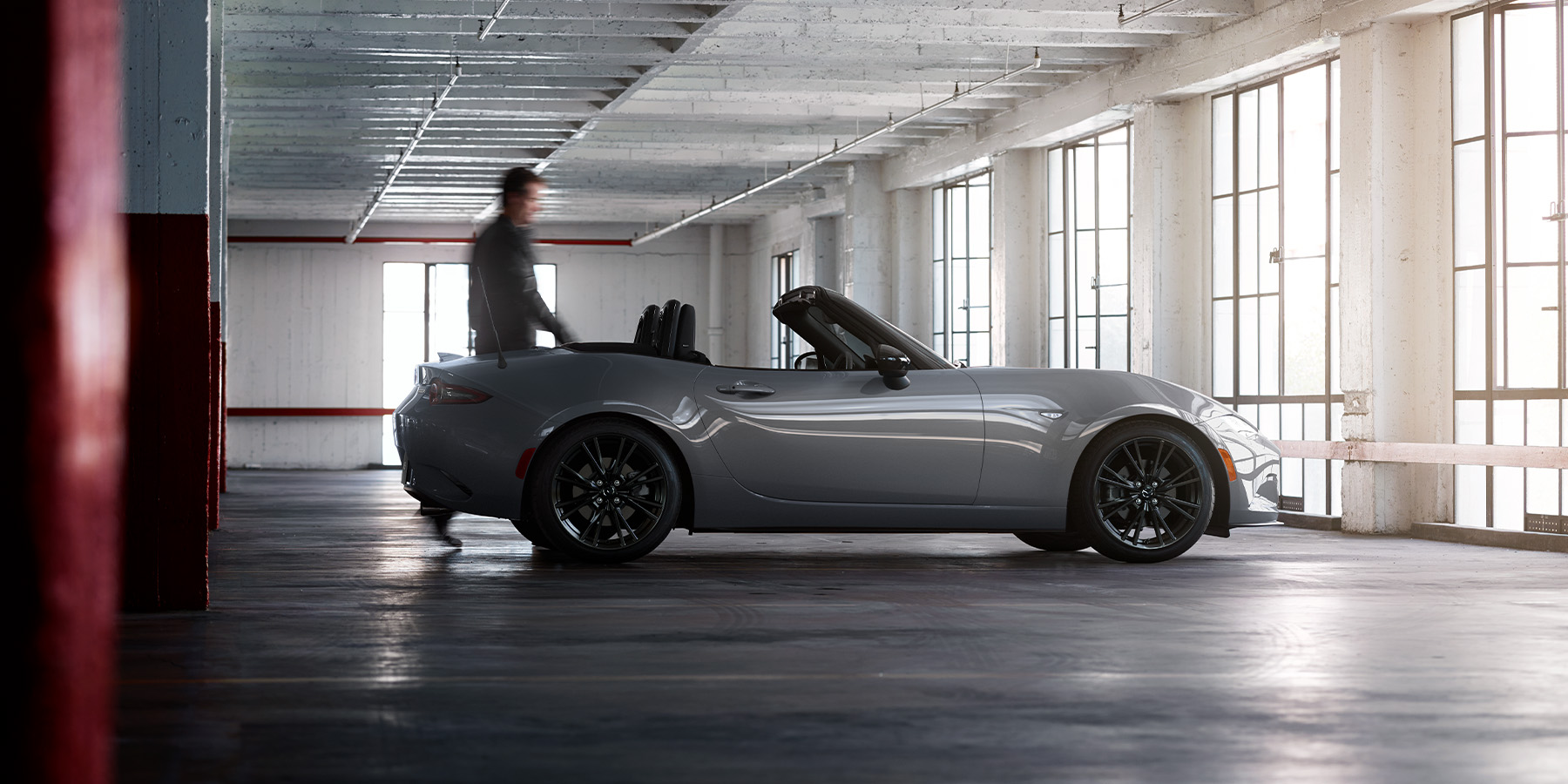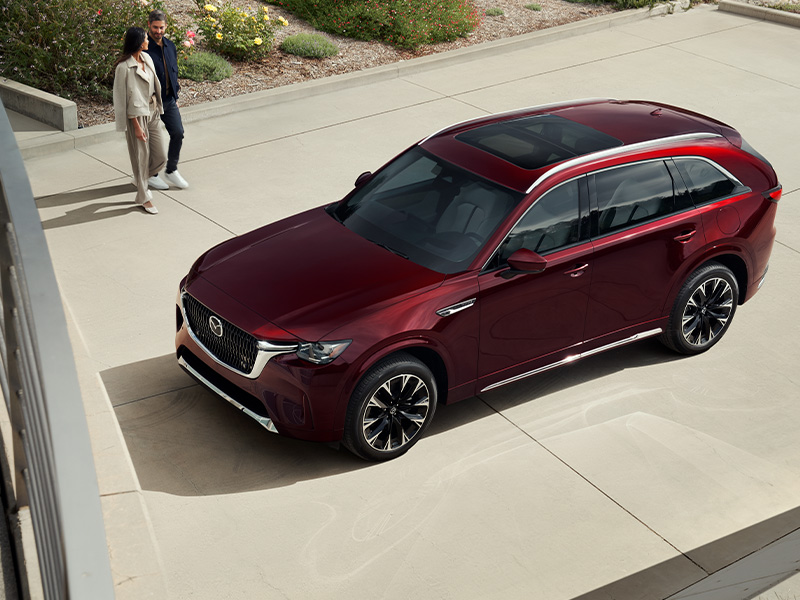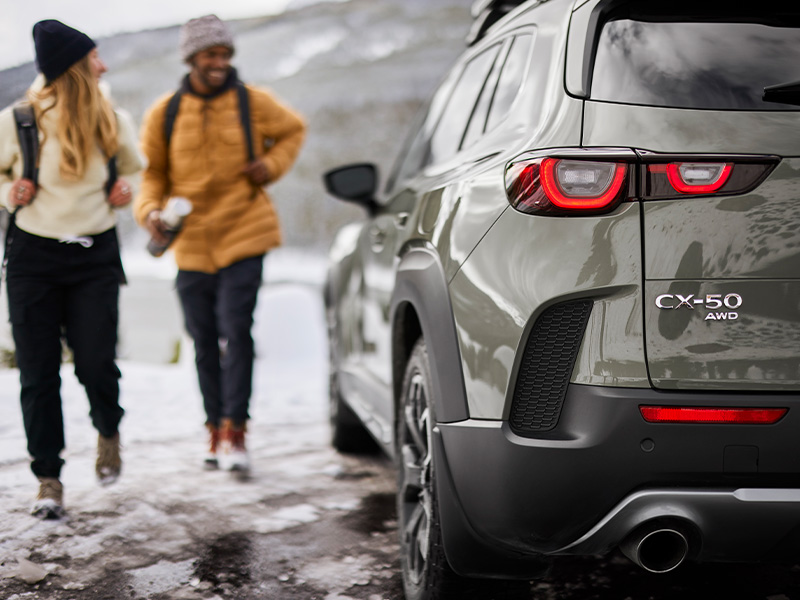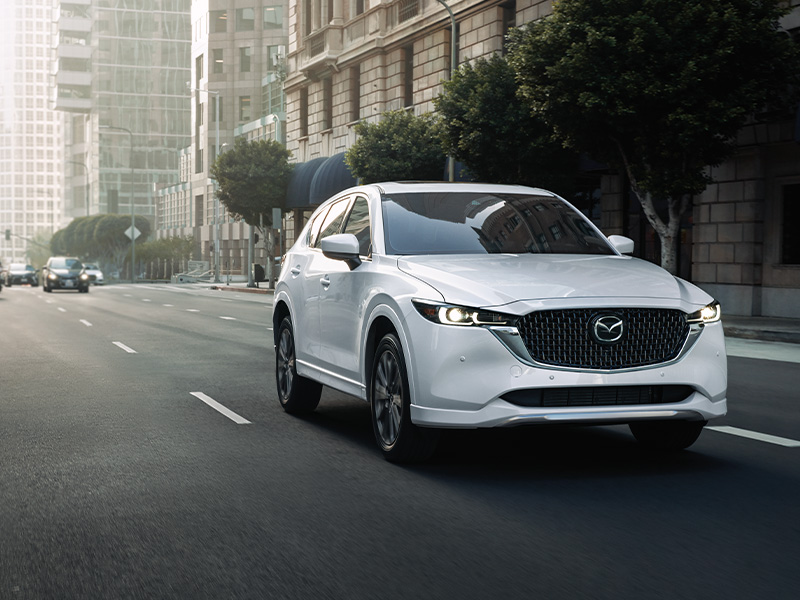What To Look For When Buying a Used Car

- Pros and cons of buying a used car
- Tips for buying a used car
- Start with research
- Investigate car ratings
- Consider a Certified Pre-Owned vehicle
- Review vehicle histories
- Check the exterior and interior for damage or issues
- Take a test drive
- Get a pre-purchase inspection
- Documents you’ll need and want when buying a used car
- Buying a used electric vehicle (EV)
Knowing what to look for when buying a used car can give you peace of mind and potentially save money in the long run — particularly if it will help you avoid the purchase of a lemon. But whether this is your first time buying a used car or you’ve done this before, the used car shopping and buying process can feel overwhelming and convoluted.
This guide gives you a rubric for what you need to keep in mind as you look for your next used vehicle, including what to check, what questions to ask, and more.
Check out the Mazda Certified Pre-Owned Vehicles

Pros and cons of buying a used car
To make an accurate assessment of what is truly a “pro” and is truly a “con” for you, you’ll want a clear understanding of your needs and desires for your next vehicle. Keep those factors — as well as the idea that none of the advantages and disadvantages below are insurmountable — in mind as you read the below.
Advantages
There are two primary compelling reasons to opt for a used car purchase. Firstly, used vehicles come with a more budget-friendly initial price tag; the first owner has already absorbed the steepest depreciation hit. This can translate into savings and may lead to lower insurance premiums due to the decreased vehicle value.
Moreover, individuals may favor slightly older models for the insights such vehicles offer into long-term reliability, real-world fuel efficiency, and the availability of aftermarket upgrades and accessories.
Notably, the used car market boasts a diverse array of vehicle options, with fewer in-car subscriptions and a broader selection of manual transmission-equipped models, such as the Mazda3 and MX-5 Miata. (also available as automatics).
Here’s a quick list of potential advantages of buying used:
- Cost Savings: Typically, lower initial purchase price than new cars of the same model.
- Reduced Depreciation: Buying used can help you avoid the steep depreciation in value experienced by new cars.
- Lower Insurance Costs: While not always true, used cars can come with lower insurance premiums due to lower vehicle value.
- Proven Reliability: Used vehicles have more reliability data and real-world performance reviews.
- Diverse Selection: Used cars come in a wider variety of models, including discontinued ones.
- Lower Taxes: The purchase of a used vehicle often means the owner pays lower taxes compared to new vehicle purchases.
Disadvantages
Vehicles tend to improve in terms of refinement, safety, and efficiency over time, although those advancements within models tend to be incremental. Newer models are also more likely to include active driver assistance systems which, along with a vigilant driver, can help save lives. Advances in materials and construction have contributed to slightly quieter cabins in newer cars, although this difference may go unnoticed unless one avoids utilizing in-car entertainment and phone features. Lastly, it's worth noting that securing a used car loan may entail a higher interest rate compared to a new car loan.
Here’s a quick list of potential disadvantages of buying used:
- Limited Latest Features: Used vehicles — particularly much older used vehicles — may lack the latest technology and features.
- Potential Maintenance Costs: The road takes a toll on your car, and older vehicles may require more maintenance, even if the previous owner took good care of their vehicle.
- Unknown History: While there are more tools available now that help you learn about a car’s history, depending on where and how you buy your used vehicle, you may be operating without knowledge of the vehicle's past usage and maintenance.
- Reduced Fuel Efficiency: In general, older vehicle models may not be as fuel-efficient as newer ones and may continue to lose efficiency over time (particularly if it’s not maintained).
- Higher Interest Rates: The purchase of a used car may entail the possibility of paying higher interest rates on used car loans.
- Limited Warranty: A used car may have a shorter or expired manufacturer's warranty.

Tips for buying a used car
1. Always start with research
The fact that you’re reading this article suggests you already know this, but it bears stating: the purchasing of a used car does not start at a dealer, it begins with research — with discussions with professionals like a loan officer or CPA, and with investigations of library resources, online sources, vehicle advice, data repositories, and manufacturer websites.
This process will help you refine your list of viable purchase options and set the stage for meaningful test drives. The most successful used-car purchases require time and consideration, not spur-of-the-moment decision-making.
2. Investigate car ratings
There are numerous websites dedicated to new and used-car shoppers. Many of those websites drive traffic to dealerships or other sales sites, and some are owned by dealerships that want to sell you their brand(s) of cars. That’s not necessarily a bad thing, but it’s important to keep in mind.
There are, however, a few more independent sites, including:
- Insurance Institute for Highway Safety: Offers safety and headlight ratings.
- National Highway Traffic Safety Administration: Provides federal safety and recall information.
- Fueleconomy.gov: Houses the EPA's official ratings and has information on tax credits.
- Consumer Reports: Offers testing and reliability reports.
Sites like AAA, and Kelley Blue Book also frequently offer quality journalism, information about car value, and more.
You can use these resources to evaluate used cars for safety, usability, and more, all before you spend time on car lots and taking vehicles out for a test drive.
3. Consider a Certified Pre-Owned vehicle
The particulars of any single brand’s Certified Pre-Owned (CPO) program vary, but most CPO vehicles have been inspected by a factory-certified technician at a dealership. They also frequently have a known service history and may be offered with a warranty. They are usually recent models with modest to low mileage and, in some cases, may have been used only by the dealership.
For example, Mazda has a Certified Pre-Owned Vehicles program that offers a vehicle warranty, powertrain warranty, a history report, inspection, deals on certain repairs, and more.

4. Review vehicle histories
Once you narrow down your search to particular vehicles, you’ll want to check their vehicle history. You can do this by plugging the car’s Vehicle Identification Number (VIN) or, in some cases, its license plate, into third-party sites like or CARFAX. These sites may offer this information for free or for a nominal fee, and can show you:
- The number of previous owners
- Reported accidents and severity of accidents
- Miles driven
- Emissions testing data
- Title information
- Where the vehicle was registered (rust belt, coastal salt area, flood-prone area, dry desert, etc.)
For any reported accident, seek out details such as repair receipts. A parking lot fender bender with proper repair shouldn’t disqualify a car for purchase; but a salvage title car will only work in special circumstances, for example on a farm or ranch. Always check with your insurer first.
Vehicles owned by enthusiasts and club members tend to be well cared for, and many are sold on model-specific forums. Those forums are useful for finding common problems you should check on, too.
Finally, low mileage is typically a good sign but very low mileage could indicate a number of things, from a car that is sitting around for a long time (which can result in rubber gaskets and seals drying out, as well as heater and radiator issues), to the vehicle being owned by a service member deployed overseas who drove the car some distance once or twice a month.
Bottom line: It’s always wise to get as many details as you can.
5. Check the exterior and interior for damage or issues
Once you’ve chosen a car or two, it’s time to set aside an hour or more for an inspection. You should anticipate getting a little dirty, so don’t wear your favorite outfit. An inspection should be performed in broad daylight since artificial light can more easily hide imperfections. (You may also want to schedule another inspection for night-time in order to perform a test drive in the dark.)
This is the part of the used car buying process that intimidates most people. Keep in mind that, even if you know nothing about cars, simple observations can tell you a lot. And again, if you decide this is beyond your comfort level, you still have the option to buy a certified, pre-owned vehicle from a dealer.
What to look for on the exterior of a used car
- Look for dents and scratches: These aren’t uncommon but may indicate a lack of pride in ownership or inadequate maintenance. Pay attention to any clustered dents, which might suggest proximity to an inconsiderate neighbor in a garage.
- Check the paint for consistency: Is the paint color universal all over the car? Or is a door, fender, or bumper a slightly different color? Different paint colors may indicate replacement parts, accidents, or neglect. The roof is usually the first to fade, so use a stool if you can’t see it.
- Check the doors:
- Is the space between the car door and the body panels of the vehicle even? This space is typically a few millimeters wide.
- Are the rubber seals around the doors and the door openings (and trunk) in good shape, without tears, rips, or missing chunks?
- Do any of the doors droop when you open them?
- Are any of the doors difficult to open or shut?
- Inspect for rust and corrosion: Look underneath the doors, around the radiator, behind the tires, underneath the trunk, and underneath floor mats. These are the first places you’ll find rust or corrosion if it exists. Bubbled car paint may also indicate corrosion.
- Check the lights: Are the lights free of fogged lenses and internal condensation? Do they all work?
- Assess the windows: Windows get stone chips, but any crack will grow, and most chips that are more than a couple of millimeters may lead to a crack.
- Check the tires: Are all four tires the same model and type? Are they worn evenly? And are the date codes within the last six or seven years?
What to look for on the interior of a used car
- Smells: Get into the car and let your nose do some work. A stale or mildew smell could indicate a water leak or ventilation system problem — check for damp floor mats even if they look fine. Cigarette smoke, animal scents, and fragrance overspray can be annoying and difficult to eliminate.
- Upholstery: Is the door side of either front seat worn down from people sliding in and out of the vehicle? Is the upholstery in good shape, including inside fold-down armrests and under the headrests? What about the leather on the steering wheel or shift boots?
- Seat controls: Do all the seat controls work and travel fully in every direction available to them? Do folding seats release and latch easily?
- Seatbelts: Are the seatbelts in good shape and smooth to full extension/retraction?
- Interior height and comfort: Do you and frequent riders fit comfortably in any of the seats they might use?
- Dash switches and buttons: Do all the switches and buttons work and turn on and off what they need to? Do they release smoothly? Pay attention to those on horizontal surfaces and near cupholders, where spills are most likely to occur.
- Window washing apparatuses: Check the (front and rear) so you don’t drag a dry wiper across the glass, and check whether the windshield wipers need to be replaced while you do.
- Windows: Do all the windows, including the moonroof and window shades, function smoothly? Check functionality in both directions, using the switches in both the front and back seats. Check for any “auto” or one-touch functions.
- Floor mats: Are any floor mats clean and in good shape, including the trunk/cargo area?
- Spare tire: If the vehicle has a spare tire, is it in good condition? Are a jack or any tools — including any wheel lock socket — in the car?
- Sound system: Does the sound system work on all radio bands and inputs, and are the various audio adjustments functioning?
- Dash lights: When you first turn the key or ignition on do all the warning lights illuminate (a bulb check function)?
- Visibility: Check outward visibility by having someone walk around the car at a distance of 20 feet. This will help you find blind spots. The newer the car, the larger the blind spots are likely to be.
6. Take a test drive
Every vehicle has its own characteristics, responsiveness, and feel. Try to go for a test drive in as many road conditions as you can, including at night.
- Handling and controls: Do all the hand and foot controls, including pedals, gear selector, etc., operate smoothly? Does the car respond as you expect?
- Shifting: Does the vehicle shift smoothly, or does it sometimes feel undecided about which gear to choose?
- Steering and brakes: Do the steering or brakes feel sensitive, darty, numb, or benign? Are you comfortable with the way the steering and brakes of the car handle?
- Alignment: On a straight, level road with no crown (a peak in the middle of the street) does the vehicle tend to go straight ahead or require significant steering attention? (There may be nothing wrong, but some cars require more steering than others, which gets fatiguing on long trips.)
- Merging: Does the vehicle have the power you want to merge comfortably?
- Noises: Does the vehicle make any unusual sounds or noises? Are they regular or intermittent? Is there wind noise around one mirror or door?
- A/C and heat: Is the car able to heat and cool itself comfortably and quickly?
- Defrosters: Do the defrosters and wipers on the front and rear mirrors and wipers clear the window area?
- Infotainment systems: Does the infotainment system (the computer that typically includes navigation, phone, audio, settings, etc.) function, both parked and in motion? Note that many cars limit what can be done within the infotainment system when the vehicle is in motion, and some vary depending on whether there is a right-front passenger in the vehicle who could also use the system.
- Night considerations:
- At night, are the instruments and controls illuminated as you like in terms of color and brightness?
- Do the headlights perform well and as you wish?
- If the vehicle is equipped with a turn-following function, does it operate smoothly?
- After you drive: Are there any signs of leaks where your car was parked, either after you left or a few minutes after your drive?
7. Get a pre-purchase inspection
Now that you’ve examined the interior and exterior of your vehicle and taken it on a test drive, it’s time to take it in for an inspection. Only skilled mechanics can identify some problems. These checks are also especially useful if you’re not comfortable with or interested in checking fluids, reviewing service history, sorting tire date codes, or inspecting structures and mechanical parts. These inspections typically cost $100-200.
Always use your own mechanic or an independent service facility of your choice. A seller telling you, ”Our mechanic has already checked it,” is neither satisfactory nor safe.
Documents you’ll need and want when buying a used car
When buying a used vehicle, you'll need and want several documents to ensure a smooth and transparent transaction.
Documents you’ll need to bring if you’re buying a used car
- Valid driver's license: You'll need a valid driver's license to test-drive the vehicle and complete the purchase.
- Proof of Insurance: Before driving the vehicle off the seller's property, you’ll want to call your insurance company to add the new vehicle to your policy.
- Loan approval documents: If you're financing the purchase, you'll need the loan approval documents from your lender. These may include loan agreements, terms, and conditions.
- Other information: You may also need to bring recent pay stubs, proof of residency, and other loan basics if you’re financing your car. Check with the seller.
Important documents during the sale of a used car
- Vehicle title: This document proves ownership of the vehicle and is essential for transferring ownership to you. Ensure the title is clear of any liens or encumbrances.
- Vehicle registration: The seller will need to provide you with the current vehicle registration. This will vary by jurisdiction, but it's typically required to legally operate the vehicle.
- Bill of sale: A bill of sale is a legal document that records the sale transaction, including the purchase price, seller and buyer information, and a detailed description of the vehicle.
- Vehicle Identification Number (VIN) check: Obtain a vehicle history report or VIN check to verify the vehicle's history, including accidents, title status, mileage discrepancies, and recalls.
- Owner's Manual (OM): The owner's manual provides important information about the vehicle's operation, maintenance requirements, and warranty details. It's helpful to have this for reference.
- Maintenance records: If available, request the vehicle's maintenance and service records. These documents can provide insights into how well the vehicle has been maintained and whether it has undergone necessary repairs.
- Emissions and safety inspection certificates: Depending on your location, the seller may need to provide certificates proving that the vehicle has passed emissions and safety inspections. Check your local regulations.
- Release of liability form: In some areas, a release of liability form is necessary to notify the DMV or relevant authorities that you've sold or bought a vehicle. This helps protect you from future liabilities associated with the vehicle.
- Warranty information: If the vehicle is still under warranty, obtain the warranty information, including the coverage details and any transferability information.
- Seller's disclosure statement: Some states require the seller to provide a disclosure statement detailing known defects or issues with the vehicle.
- Smog Certificate: In regions with smog testing requirements, ensure you receive a valid smog certificate showing compliance with emissions standards.
Questions to ask when buying a used vehicle
With the amount of recent car data available online and the backup of inspections at your disposal, the questions you want to ask sellers — particularly independent sellers — should be to gauge trustworthiness. Ask:
- How the owner used the vehicle — how often they drove it and in what conditions.
- Whether they took the vehicle on particularly long trips (in terms of mileage and duration).
- Ask why they’re selling the vehicle, particularly if the vehicle is high-end or highly rated.
Special considerations for buying a used electric vehicle (EV)
In addition to the points relevant to traditional gasoline-powered cars, the purchase of a used EV entails one special consideration. You’ll want to take the EV to a mechanic to assess the battery's health and remaining capacity; the state of an EV’s battery is crucial for understanding the overall longevity of a used EV.
If the seller has them, request the vehicle's charging history and battery maintenance records to gain insights into how well the battery has been maintained. Keep in mind that battery degradation occurs over time, affecting the vehicle's range. So, understanding the current state of the battery is crucial for long-term satisfaction.
Buying a Certified, Pre-Owned Mazda
Facilitate your used car buying experience and drive off the lot with peace of mind when you purchase a Certified Pre-Owned Mazda at a dealer near you.
Our carefully curated selection of CPO Mazda vehicles offers you the opportunity to enjoy the best of both worlds – the style and performance of a Mazda, along with the confidence of a thoroughly inspected and certified vehicle. From knowledgeable sales teams to our expert service professionals, we're here to support you every step of the way.
Your next adventure starts here – find a CPO Mazda today!
This article is intended for general informational purposes only and is based on the latest competitive information available at the time of posting. Information herein is subject to change without notice and without Mazda incurring any obligations. Please review a variety of resources prior to making a purchasing decision. Visit Resource Center for more articles.




















